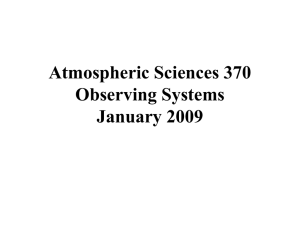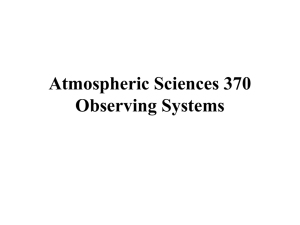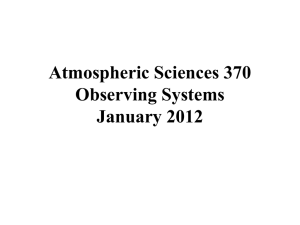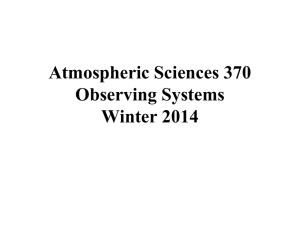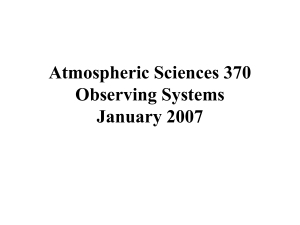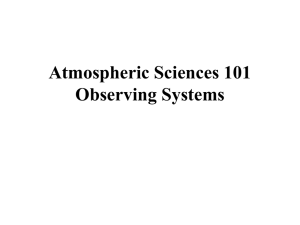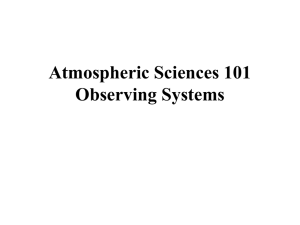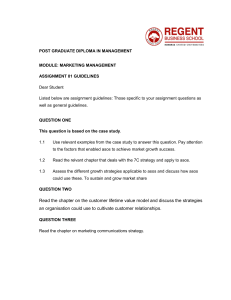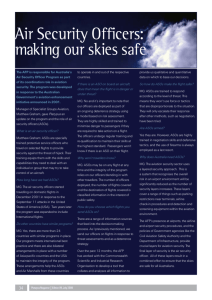Observing Systems - Atmospheric Sciences
advertisement
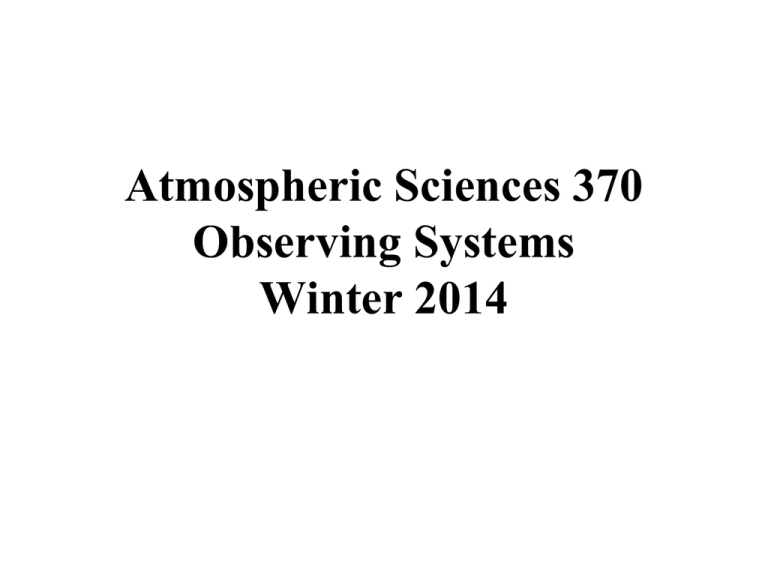
Atmospheric Sciences 370 Observing Systems Winter 2014 ASOS: Automated Surface Observing System: Backbone Observing System in the U.S. ASOS • Located at primary and secondary airports • Sponsored by the FAA and NWS • High quality instrumentation that is well maintained and calibrated. • Reported in METAR format (more later) Hydrothermograph Precipitation Gauges Laser Weather Identifier Acoustic Anemometer Still used in many other systems Anemometer Wind Vane Laser Ceilometer The ASOS Freezing Rain Sensor uses an ultrasonically vibrating probe to detect the presence of icing conditions. The vibrating frequency of the probe decreases with the accumulation of ice. Lightning Sensor Visibility Sensor Full ASOS system in Arizona METAR Format • ASOS data (and airport observations worldwide) are transmitted in METAR format. • Name came from the French words, MÉTéorologique ("Weather") Aviation Régulière ("Routine"). • Example: KSEA 042353Z 11008KT 10SM FEW050 SCT070 OVC090 09/03 A2879 RMK AO2 SLP756 60001 T00940033 10117 20083 58013 • Will learn more about it in Lab Observing Heights (ASOS and most official obs) • Temperature and dew point (2-m) • Wind speed and direction (10-m) Other Surface Networks •Bureau of Land Management •RAWS •Agrimet •PAWS •Department of Ecology •Puget Sound Clean Air •BC Hydro •BC Olympics •Weather Underground •Many more! NWNet: Regional Real-Time Collection of Over 70 Networks Over the Pacific Northwest Oklahoma Mesonet Networks of Networks UW: We collect data from about 70 networks in real time over NW Mesowest: Collects about 100 networks over the western third of U.S. MADIS: national collection of mesonets Marine Reports Ocean and Lake Weather Buoys Anchored Drifting Buoys Wind Pressure Coastal Marine (CMAN) Reports from the Coast Guard Northwest Buoy and CMAN Locations Ship Reports: Marine VOS Program Volunteers Observers--generally 6-hourly reports Highly variable quality and frequency Satellite Microwave Scatterometer Winds QuickScat Satellite Bounces microwaves off the ocean surface Capillary waves dependent on wind speed and directon Satellite Altimetry Upper Air Data Radiosonde Radar Wind Profiler and RASS (Radio Acoustic Sounding System) Seattle Profiler/RASS Profiler Locations ACARS: Aircraft Observations Generally on wide-body aircraft Aircraft Communications Addressing and Reporting System Now getting TAMDAR data from AIRDAT/Panasonic: Commuter and Short Haul Aircraft New Satellite Observing Capabilities Cloud and Water Vapor Track Winds Based on Geostationary Weather Satellites GOES sounder unit Satellite Temperature and Humidity Soundings GPS Sounding • A constellation of GPS satellites orbit the earth. • A collection of other satellites can receive the GPS signal • By measuring the delay in time as the GPS signal is bent by the earth’s atmosphere, one can acquire density information that can be used to create temperature and humidity soundings. • Can do this with fixed receivers on earth or with receivers on satellites--the COSMIC project. Weather Radar During the early 90s, the NWS installed a network of powerful Doppler Weather radars, a.k.a. NEXRAD WSR88D NWS Radar Sites Weather Radar • Reflectivity (precipitation intensity) • Doppler Velocities (radial velocities) • Polarimetric Information (precipitation type and other information? • Much more later in class Typical Observation Errors at the Surface (Important when doing analyses!) • Sea Level Pressure – Low-Elevation land stations +-.5 mb – Ships +- 1-5 mb • Temperature: +-1C • Wind Speed: +-2-5 knots, very light winds often a problem—especially for classical anomemters. • Relative Humidity: +-10% Typical Radiosonde Errors • Geopotential heights: – – – – 700 mb (hPa): 5-10 m 500 mb 10-15 m 300 mb 15-20 m 100 mb 20-30 m • Temperature: +-0.5C • Wind speed: +-5%,+-10 degrees Terminology • Direct versus Indirect observations – Direct: measurement at the location of the instrument – Indirect: remotely sensed using radiation measurements • Active versus passive remote sensing – Active: instrument emits radiation, analyzes return – Passive: analyzes incoming natural radiation
